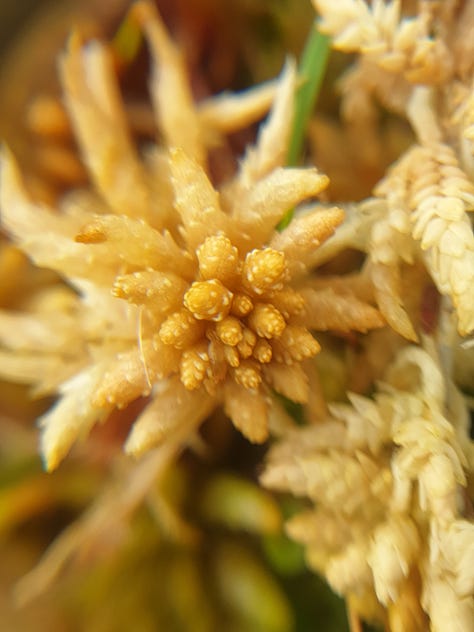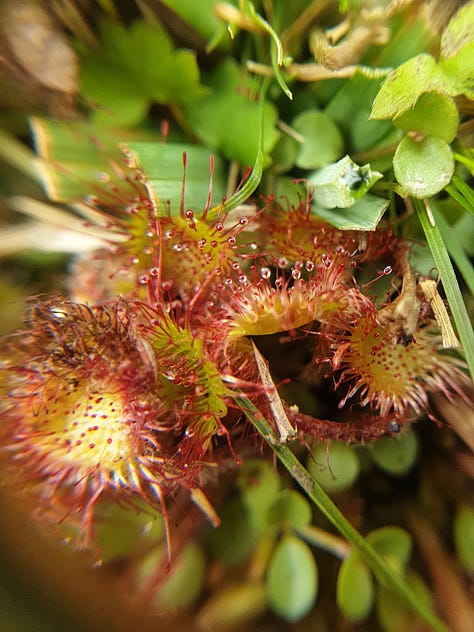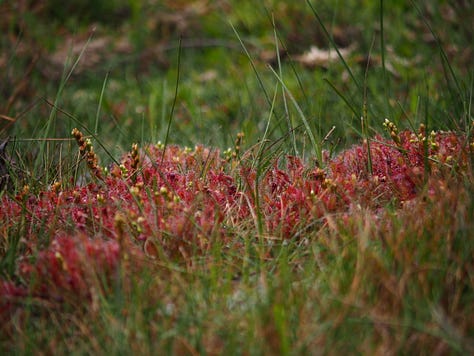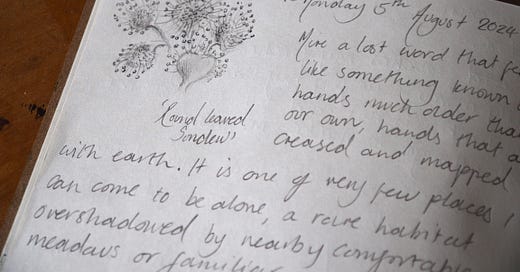Mire, a lost word that feels like something known to hands much older than our own, hands that are creased and mapped with earth. It is one of very few places I can come to be alone, a rare habitat overshadowed by nearby comfortable meadows or familiar woodland. Not many want to come here perhaps a legacy of a time where it was believed that you may become entranced by a small being known as Wil-O-The Wisp or Fool’s flame as it sends up lights across the bog, luring you to unsafe, saturated ground where you are sure never to return from. Today though the only flame visible is that of the hot August sun and being a lover of cold weather I think the flame of Wil-O-The-Whisp would be preferable right now.
I enter a small field mainly laid to thin grass no longer than an inch high with neat piles of rabbit droppings and spherical patches of bramble thickets, not as thick stalked as their hedgerow cousins and with berries only a few beads round, barely a blackberry at all. They are still fairly tight and even the darkest fruit is sharp on my tongue.
I walk into the next field where the main fruiting body of the mire sits. It is not a large area with the whole site being just under five acres and the mire probably half of that but what it lacks in size it makes up for in incredible detail. At first glance it looks, well, like not a lot but the mire holds its secrets close and one needs to join the earth to reveal them.
Sedge heads stand proud and tall, comfortable with their watery roots even in August the boggy ground sucks at my boots and I am glad I wore them having existed in either flip flops or my own feet for a while now. I pick my way across a careful route not wanting to damage this precious habitat. It may seem hardy with its unrelenting wetness and short stubby features but mires are scarce and so have every right to protect themselves. The specific mire I am at today is a springline mire and a key feature of the Blackdown Hills for without its soil structure there would be no woodlands where there are, no meadows where they are, no farms where there are. It shapes the places more appealing to many whilst silently feeding the land.
The ground sinks between two rocky outcrops no more than a couple of feet high with feral rocks having fallen by the wayside appearing like sun washed bones in between the sunken ground. It is visibly wet here and seemingly unmoving but for a small occasional bubbling motion from the earth like slow breath from some invisible submerged creature. Everything here is stunted included the five dark mahogany ponies that have suddenly become aware of my presence. They are no higher than my chest, stocky and bold with two ponies round and dark with life, a stallion with a grey streak down his thick wiry mane and two foals all fluffed about the edges with an inbetween coat. They come closer all the while tearing neatly at the ground with soft, sensitive lips. I watch up close with no idea how they manage to pass by the bright yellow tormentil flowers, alien headed sphagnums and the plant I came to see the sundews.
There is something deliciously odd about this place but I’m not sure you would notice if you were not on your knees for everything is in miniature. The sundews are tiny, each head no bigger than my little fingernail held on an orangey red stalk that manifests from somewhere deep and unseen amongst the sphagnum. The head itself is a tiny lime green ear covered in soft red hairs but perhaps the most alluring part is the little globes of dew caught all about the hairs and glistening in the sun. The more I look at the plant the more the heads do look like little ears and it would not surprise me to know they are listening. To an insect these are treacherous dinner plates with themselves as the supper ontop. You see the sundews home is not enough to sustain them they have become greedy over time and have developed a taste for meat. Luring the insects in with those glistening globes that then hold the insects fast whilst the plant wraps its ear around them and slowly devours its meal. Perhaps these tiny plants are the real Will-O- The-Whisp and I decide to come away as given half a chance I am sure these fierce plants would eat me.
Before I knew the sundews were here, the first time I came, I remember the mire having this sense of digestion. That may sound odd but in a land of carnivorous plants surely anything goes? and now as I lay my head on the ground I swear I can hear something below the surface, a rumbling guttural sound and my heart quickens as I listen to that voice. This place is digestion, somehow I am not sure. Like a gut it is full of strange flora, the bubbles moving through the juices and the sphagnum transforming what’s gone into what is. I think about our own stomachs, the vulnerability of them, the way we hold them when they ache or how so many of us cover them so as not to be noticed and it makes me wonder about this most vulnerable habitat and how it will survive our insatiable human hunger.










